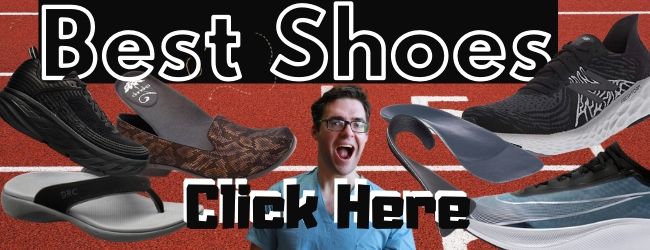Swollen Feet, Ankles & Legs? [Causes & Best Home Treatment]
Do you have swollen feet, ankles or legs? The 100% best treatment options can really improve both your PAIN & SWELLING as quickly as possible!
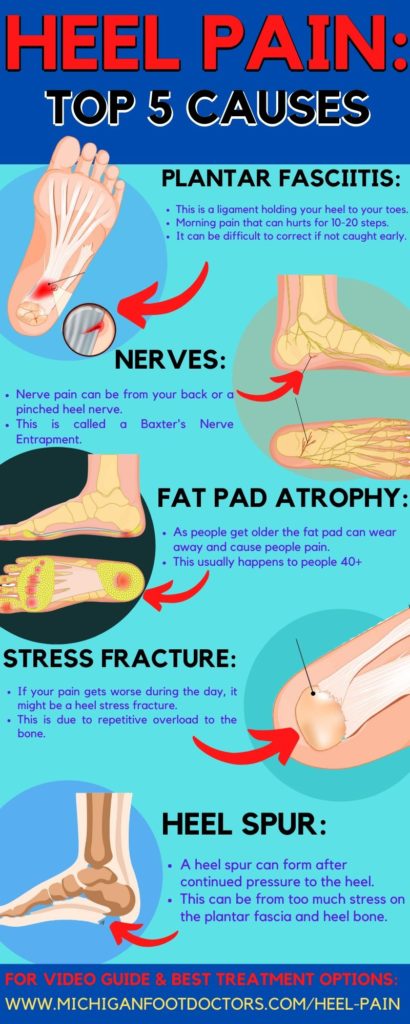
Table of Contents
Heel Pain Causes: Picture & Photo Gallery
Look:
- One of the top causes of heel pain is plantar fasciitis. This is damage to a ligament that holds your heel to your toes.
- Another root cause of heel pain has flat feet.
- There are also photos of heel spurs that can occur to the bottom of your heel (plantar fascia insertion) and the back of your heel (Achilles tendon insertion).
- Baxter’s nerve entrapment can also happen at the bottom of the heel.
- An underlying cause is an overpronated flatfoot or an over a supinated high arched foot.
- A plantar fibroma is a thick nodule that can occur within your plantar fascia ligament and contribute to plantar fasciitis.
- This can lead to the formation of a heel stress fracture( AKA calcaneus stress fracture.)
Please click on the gallery for a guided tour through heel pain conditions!
Swollen Feet, Ankles & Legs Overview:
Below are the most common causes for swollen feet, ankles and legs.
- No matter where your swelling and pain: make sure to look at some product options and see your podiatrist!
- A large portion of swelling can be from health conditions that have nothing to do with your feet or ankles.
- These causes focus on causes below your knee.
Causes:
Metatarsalgia:
- The second most common cause of bottom of the foot pain is called metatarsalgia.
- This is a very painful condition used to describe pain in the ball of the foot.
- At the ball of the foot is the area of your toes there were and where your toes meet the front of the foot.
- The condition is called metatarsalgia because the long bones in this area are called the metatarsal bones.
- This type of pain is most common in people with very high arched feet, running and jumping activities, long-standing during the day. These bones and joints can become very swollen.
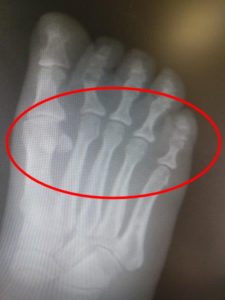
This is most common in people who have very tight hamstrings calf muscles are putting much more pressure on the ball the foot. This can lead to neuroma, metatarsal or even stress fracture pain.
Plantar Fasciitis:
- Plantar fasciitis is the single most common cause of foot pain.
- The plantar fascia is a thick band of tissue that runs across the bottom of your foot connecting your heel to the area over your toes.
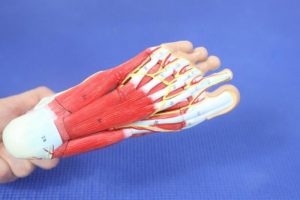
- People with plantar fasciitis experience pain across the bottom of their foot usually in the mornings and after strenuous exercises like going for a jog.
- You might even have heel pain while simply pushing at the bottom of your heel while sitting in place with your thumb.
- The real key to plantar fasciitis is to decrease the swelling and inflammation. It does not make sense to start stretching exercising and beating up on an already damaged muscle.
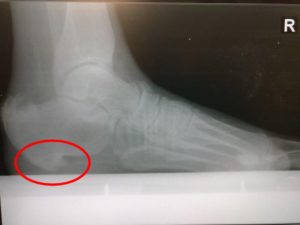
- You have to think about this like a broken ankle, you wouldn’t exercise or stretch a broken ankle, it does need to rest to a certain degree.
- Just applying a cream or taking a medication will not make it better in one day, it can take weeks!
- There is physical damage to this band of tissue, it does need time to heal and you need to do all the right types of stuff to keep pressure off.
- The secret is to find out how to keep moving while avoiding this type of pain.
- Read the end of this guide to see just how to do that.
Posterior Tibial Tendinitis:
- The posterior tibial tendon goes down the inside of your leg towards the center line of your body and attaches to the bottom inside of your foot.
- This is the tendon that can sometimes be associated with shin splints.
- This tendon helps support your foot’s natural arch, this can also cause pain and be associated with plantar fascia pain.
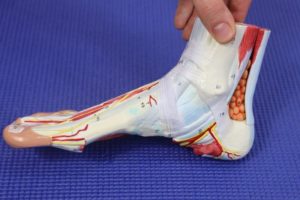
- Just like plantar fascia pain, it does not always make sense to start working out and stretching this muscle.
- Just like you would not stretch or work out a broken ankle, does not make sense to stretch out damaged or tendon.
- This is where a lot of the advice on the Internet goes wrong.
- A true injury needs time to heal and you need to make sure you are healing correctly.
- This is another condition where a podiatrist can really come in handy to make sure that you don’t have a pretty significant injury.
Insertional Achilles Tendonitis:
- They Achilles tendon and is the biggest tendon in your body.
- The gastrocnemius is the large calf muscle that attaches to the Achilles tendon.
- As people get older and less elastic, the Achilles tendon can become very irritated, inflamed and painful as it inserts into the back of a heel.
- This can rate me into the calcaneus heel bone and cause significant pain and tenderness.
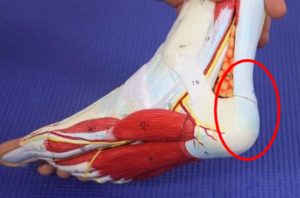
Achilles Tendonitis Heel Pain:
- The most common cause of achilles heel pain is an overuse injury.
- This leads to inflammation of the achilles tendon, this leads to Achilles heel soreness.
- This will appear as morning pain that gets better with 15-20 minutes of walking!

Achilles Tendonitis Heel Pain Symptoms:
- Pain in the back of the heel.
- Sore insertion of the achilles heel.
- Swelling may occur.
- You may experience Achilles heel soreness in the morning.
- The stiffness and pain go away with walking.
- Decreased strength.
- Sluggishness in calf muscle.
See the Achilles Heel Pain Treatment Section Below.
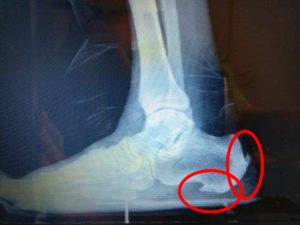
Home Remedies for Swelling:
Elevation & Compression:
- Elevate your feet over the heart.
- Compression socks – they feel good, studies are mixed
- Compression pants – also feel good, studies are mixed, but they definitely work.
Ice The Swollen Area:
- Ice for 10-15 minutes: research is theoretical, get rid of chronic inflammation.
Best Shoes For Swollen Feet:
- good shoes and good orthotics
- Wear house shoes, this makes a huge difference.
- Feet swelling can increase your shoe 1/2 a size from morning to night time. So make sure to fit your shoes in the evening.
Podiatrist Treatment:
- Prescription compression stockings: These are high grade stockings that can really make a difference.
- Stocking donner: These can help you put on your compression stockings.
- Unna boot wraps: Your podiatrist can help you put these on if there is swelling.
Excercises for Swollen Feet:
- Ankle pumps, push down and up.
- Studies show simply stepping on the foot can help.
- Compression boots that push fluid up into the leg.
- Straight leg raises.
Best Swollen Feet Home Treatment:
- There are usually two phases to bottom of the foot pain treatment.
- The two phases of treatment include controlling the acute inflammation, and correcting the biomechanics which led to the problem in the first place.
- If the tendons and ligaments are inflammed, they are almost frozen in place and cannot function properly.
- Once the inflammation is decreased, we need to correct the biomechanical causes to ensure that they can never become over worked and inflammed again!
- This doesn’t matter whether it’s plantar fasciitis, plantar fibroma, sore bottom of foot, or even Achilles tendon pain. Treatment is all roughly very similar.
leg pain, painful legs, swollen legs, swollen ankles, swollen legs and feet, leg pain and swelling, leg swelling, ankle swelling, swelling in legs, leg lymphedema, swelling in legs, swelling of legs, swollen knee, swelling in feet, swelling of feet, painful swollen legs, painful swollen feet, swollen feet, leg edema, edema, physical therapy
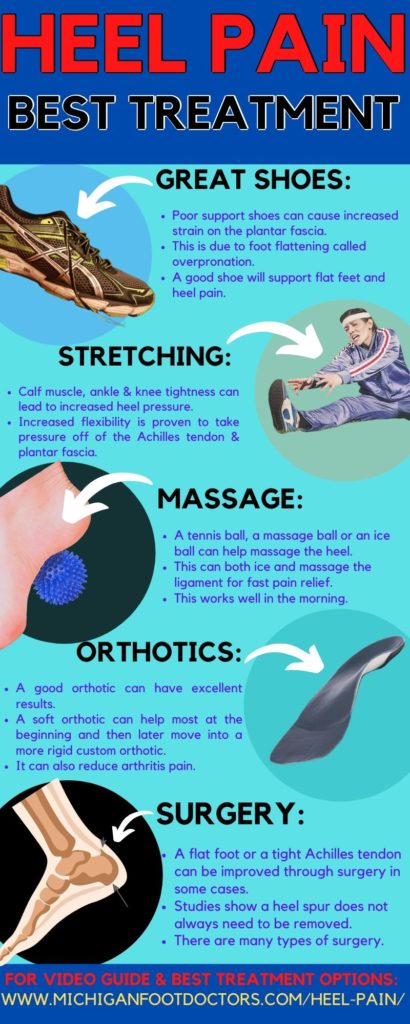
Best Heel Pain Products:
- There are usually two phases to treating plantar fasciitis pain.
- The two phases of treatment include controlling the acute inflammation, and correcting the biomechanics which led to the problem in the first place.
- If the tendons and ligaments are inflamed, they are almost frozen in place and cannot function properly.
- Once the inflammation is decreased, we need to correct the bio-mechanical causes to ensure that they can never become over worked and inflamed again!
- This doesn’t matter whether it’s plantar fasciitis, plantar fibroma, sore bottom of foot, or even Achilles tendon pain. Treatment is all roughly very similar.
Plantar Fasciitis or Achilles Tendonitis Inflammation:
Massage & Ice Products:
- Ice is the an excellent option that can be safe for almost everyone.
- There is some debate whether icing is worth doing, but for chronic pain this can help limit the need for medications and keep your options open.
- This works great for your arch, less for the ball of the foot.
- The more muscle and ligament tissue there is, the better ice will work there.






Menthol Based Gels:
- Biofreeze is one of our favorites.
- These gels have been studied to work 2x as long as ice.
- This works great for the ball of the foot.
- This can be very effective for bottom of the heel and Achilles tendon sore regions.








Massage Sticks:
- These can work great for loosening your muscles.
- This allows less tightness and pressure on the ball of your foot.
- This is very effective for the arch, the gastrocnemius or calf muscle and for the hamstring and thigh muscles.
- This also works very well for the gluteus muscles if you are having butt cheek or hip pain.






Remove the Plantar Fascia or Achilles Tendon Stress:
- The key is to prevent future pain.
- This means keeping you active while keeping stress off of your plantar fascia tendon. This will prevent future re-injury and development of plantar fasciitis.
- If you can get rid of the pain and swelling, this will let you start walking normally.
- If you can walk normally, the vast majority of your pain should gradually start to go away.
- The best way to ensure that your plantar fascia, foot and ankle ligaments are not overworked is to support them.
- The best way to support them is to use great orthotics and great shoes.
- Some people may also need to rely on supportive ankle braces and other supportive modalities.
The Best Heel Pain & Plantar Fasciitis Shoes:
- Getting a great supportive pair of shoes will make sure that there is pressure removed from the heel and plantar fascia region.
- This is especially important if you have plantar fasciitis, heel spur pain or Achilles tendonitis.
- Consider shoes combined with a good supportive orthotic for best pain relief!
- The following link will show you what our favorites are.
Best Heel Pain & Plantar Fasciitis Orthotics:
- These are our recommended orthotics for plantar fasciitis.
- Custom orthotics can work very well, but they should not be a first line of treatment.
- There are different types for different shoes.
- Women’s shoes usually need a less bulky orthotic, but allow for less correction.
- A full length orthotic requires a running shoe, boot or comfortable walking/dress shoe.
- We recommend doing everything you can to get a good supportive shoe that can fit a full length orthotic.
- This is the best way to maximize your orthotics for great results.
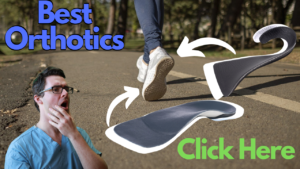
Best Full Length Orthotics:
- These will only work in wider shoes or a good supportive running shoe.
- This will not work in sandals, flats or most women’s dress shoes.








Best Dress Shoe Orthotics:
- These are a great choice for dress orthotics.






Best 3/4 Length Orthotics:
- These are great options for women’s dress shoes and thinner shoes.
- These are not the most supportive pair of orthotics.


Get A Great Dynamic Stretch:
- It is possible to stretch on your own, but these products can also really help!
- This will take pressure off of the ball of your foot.
- We personally prefer this method of stretching.








Get A Great Static Stretch:
- These devices are great for stretching while you are resting.
- This will also help take pressure off of the ball of your foot.
- This works great for plantar fasciitis.
- It can be used while watching TV or at night time.






Best Heel Compression Brace:
- A good compression brace can stabilize your foot from turning outward.
- This prevents your foot from pronated.
- Pronated foot will turn your foot outward in your foot will rub on the outside of the shoe.
- For many of her patients this has solved their pain and is very comfortable to wear inside your shoe.
- This solves both pain and outward pronation for a relatively low cost.




Best Heel Stability Brace:
- Stability brace goes little bit further than the compression brace to stop your foot from turning out.
- This takes pressure off of your heel and plantar fascia.
- At the same time this is a little bit bulkier and does not affect every shoe.
- We find people are little bit happier trying the compression brace before the stability brace.






Heel Injury:
- If you think you might have a broken heel, a calcaneal stress fracture or something of similar severity, these products might help!
- Always remember to see a foot and ankle specialist like a podiatrist if you are having plantar fasciitis or more severe pain!
Plantar Fascia Tear, Broken Heel Bone, Achilles Tendon Tear:
- If you have a traumatic injury such as a torn plantar fascia ligament, calcaneus stress fracture, heel fracture or insertional Achilles tendon injury: consider protecting your foot!
- The best way to do this is of course to see your podiatrist and get evaluated with an x-ray, ultrasound and potentially even an MRI or CT scan.
- If you are unable to do so it may benefit you to be in a cast, fractured boot, or even keep the weight off of it with a rolling knee scooter or other protective devices.
- We as podiatrists frequently take patients off work for very long period of time when they suffer a traumatic injury, unfortunately there is no other way around us in labor jobs.
- If you have a sit down job there are ways to get people back to work quicker, but this can be very difficult otherwise.
Heel Injury Boot Treatment:
- There are pros and cons to using a boot to treat your heel injury. If you are immobilized too long the cons are that you will gradually become stiff and overworked to your other leg. The Pros are that you injured heel will hopefully have a chance to gradually heal!
- Our favorite fracture boots and their supplies:








Offloading and Scooter treatment:
- These are favorite knee scooters and walking devices:








